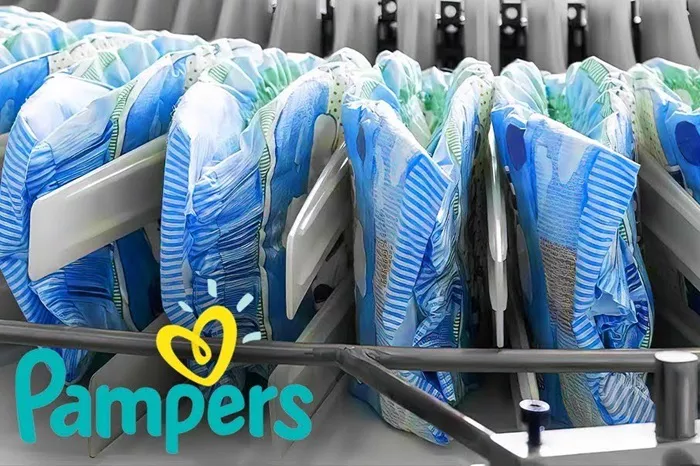Pampers, a leading brand in disposable diapers, is known for its comfort and absorbency. Understanding the materials used in Pampers is essential for making informed choices about baby care products. This article explores the components of Pampers and their functions, providing a comprehensive overview of what goes into each diaper.
Primary Components of Pampers
1. Top Sheet
The top sheet is the layer that comes into direct contact with the baby’s skin. It is designed to be soft and gentle, preventing irritation.
Material: The top sheet is made from a non-woven fabric, which is typically composed of polypropylene. This material is chosen for its softness and its ability to wick moisture away from the skin.
Function: The primary function of the top sheet is to keep the baby’s skin dry by allowing moisture to pass through and into the absorbent core. This helps to minimize diaper rash and discomfort.
2. Absorbent Core
The absorbent core is the heart of the diaper, responsible for holding and locking in moisture. This component is crucial for keeping the diaper dry and comfortable.
Material: The core consists of a combination of fluff pulp and superabsorbent polymers (SAPs). Fluff pulp is made from wood fibers, while SAPs are usually sodium polyacrylate crystals. These materials work together to absorb and retain liquid.
Function: Fluff pulp provides initial absorbency and distributes the liquid evenly throughout the core. The SAPs then absorb the liquid, turning it into a gel-like substance to prevent leaks and keep the diaper dry.
3. Back Sheet
The back sheet is the outermost layer of the diaper, providing a barrier to prevent leaks and protect clothing and bedding.
Material: The back sheet is typically made from a breathable, non-woven polyethylene film. This material is chosen for its water-resistant properties.
Function: The back sheet prevents moisture from escaping the diaper, ensuring that the absorbent core can effectively retain liquid. It also helps to maintain the diaper’s shape and provide a comfortable fit.
SEE ALSO: Where is the Cheapest Place to Buy Pampers?
Secondary Components of Pampers
1. Leg Cuffs
Leg cuffs are designed to fit snugly around the baby’s legs, preventing leaks and ensuring a secure fit.
Material: The leg cuffs are made from elastic materials, such as elastane or spandex, which provide stretch and flexibility.
Function: These cuffs create a seal around the legs, reducing the likelihood of leaks. They also help the diaper conform to the baby’s movements, increasing comfort.
2. Fastening Tabs
Fastening tabs are used to secure the diaper in place. They are adjustable to ensure a proper fit for different sizes and shapes.
Material: The tabs are typically made from a combination of hook-and-loop fasteners and elastic materials. The hook-and-loop system allows for easy adjustment and re-fastening.
Function: Fastening tabs keep the diaper securely in place, preventing it from shifting or falling off. They also allow for easy changes and adjustments as the baby grows.
3. Wetness Indicator
The wetness indicator is a feature that changes color when the diaper is wet, alerting caregivers that it’s time for a change.
Material: This indicator is often made from a special ink or dye that reacts to moisture. It is integrated into the top sheet or back sheet of the diaper.
Function: The wetness indicator provides a visual cue that helps caregivers determine when the diaper needs to be changed, promoting better hygiene and reducing the risk of diaper rash.
Tertiary Components of Pampers
1. Fragrance
Some Pampers products include a mild fragrance to help mask odors.
Material: The fragrance is usually added in the form of a scented lotion or powder, which is designed to be gentle and hypoallergenic.
Function: The fragrance helps to neutralize odors and keep the diaper smelling fresh. However, it is important to note that some parents may prefer fragrance-free options to avoid potential skin sensitivities.
2. Lotions and Conditioners
Lotions and conditioners are sometimes added to the top sheet to provide additional skin care benefits.
Material: These are usually made from skin-friendly ingredients such as aloe vera or vitamin E.
Function: The lotions and conditioners help to keep the baby’s skin soft and moisturized, reducing the likelihood of irritation and diaper rash.
Environmental Considerations
The production and disposal of disposable diapers, including Pampers, have environmental impacts. Pampers has made efforts to improve the sustainability of their products.
Materials: Pampers is working towards using more sustainable materials, such as biodegradable components and renewable resources.
Waste Management: The company has also invested in research to enhance recycling and waste management processes for used diapers.
Conclusion
Pampers diapers are composed of a range of materials, each serving a specific purpose to ensure comfort, absorbency, and leak protection. From the top sheet to the absorbent core and back sheet, each component is designed to work together to keep the baby dry and comfortable. Understanding these materials helps parents make informed choices about diapering and baby care products.
The continued development in materials and technologies reflects the commitment to improving the quality of life for both babies and parents, while also addressing environmental concerns. As Pampers evolves, it aims to balance comfort, functionality, and sustainability in its products.


